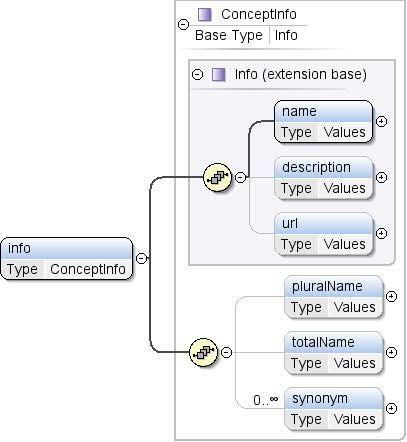コンポーネント: コンセプト
コレクションでコンテンツを整理
必要に応じて、コンテンツの保存と分類を行います。
要素: コンセプト / トピック
| 名前空間 |
http://schemas.google.com/dspl/2010 |
| アノテーション |
コンセプトが関連付けられているトピック。 |
| 図 |
 |
| プロパティ |
| content: |
複雑 |
| minOccurs: |
0 |
| maxOccurs: |
制限なし |
|
| 属性 |
| QName |
タイプ |
固定 |
デフォルト |
使用 |
Annotation |
| 参照 |
xs:QName |
|
|
省略可 |
このコンセプトが備えるトピックの一意の識別子
関連付けられています参照先のトピックは
外部、つまり別のデータセットです。参照:
外部トピックは
"prefix:other_topic_id"(「prefix」の場合)は
外部データセットの名前空間に使用される接頭辞(XML を参照)
実装します。 |
|
| ソース |
<xs:element name="topic" minOccurs="0" maxOccurs="unbounded">
<xs:annotation>
<xs:documentation>A topic the concept is associated with.</xs:documentation>
</xs:annotation>
<xs:complexType>
<xs:attribute name="ref" type="xs:QName">
<xs:annotation>
<xs:documentation>The unique identifier of the topic this concept is
associated with.
The referenced topic may be defined in the same
dataset or externally, i.e., in another dataset. A
reference to an external topic must be of the form
"prefix:other_topic_id", where "prefix" is the prefix
used for the namespace of the external dataset (see
XML namespaces).</xs:documentation>
</xs:annotation>
</xs:attribute>
</xs:complexType>
</xs:element>
|
| 名前空間 |
http://schemas.google.com/dspl/2010 |
| アノテーション |
コンセプトのデータ型。コンセプトには型を指定する必要があります
宣言したり、別のコンセプトを拡張したりします。たとえば
型宣言を行うこともできます。データの
拡張コンセプトは、サービスのタイプよりも制限が
拡張するというコンセプトです。「より制限が緩い」(LRT)は
部分順序の定義: string LRT float float LRT integer
文字列 LRT 日付文字列 LRT ブール値 |
| 図 |
 |
| プロパティ |
|
| 属性 |
|
| ソース |
<xs:element name="type" minOccurs="0">
<xs:annotation>
<xs:documentation>The data type of the concept. A concept must provide a type declaration or extend
another concept. In the case where it's extending a concept, it may also
provide a type declaration. The type of the extended concept must be less restrictive
than the type of the concept extending it.
"Less restrictive than" (LRT) is a partial order defined as follows:
string LRT float
float LRT integer
string LRT date
string LRT boolean</xs:documentation>
</xs:annotation>
<xs:complexType>
<xs:attribute name="ref" type="DataType" use="required"/>
</xs:complexType>
</xs:element>
|
| 名前空間 |
http://schemas.google.com/dspl/2010 |
| アノテーション |
コンセプトの属性。属性は、追加の
コンセプトに関する情報(例:GDP はパーセンテージ)。 |
| 図 |
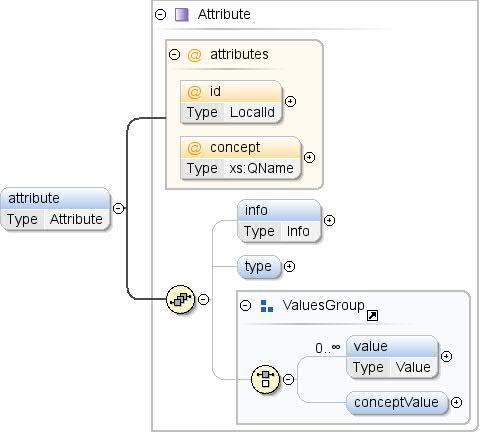 |
| タイプ |
属性 |
| プロパティ |
| content: |
複雑 |
| minOccurs: |
0 |
| maxOccurs: |
制限なし |
|
| モデル |
info{0,1}、type{0,1}、(value*
|conceptValue{0,1}) |
| 子供 |
conceptValue、info、type、
値 |
| インスタンス |
<attribute concept="" id="">
<info>{0,1}</info>
<type format="" ref="">{0,1}</type>
</attribute>
|
| 属性 |
| QName |
タイプ |
固定 |
デフォルト |
使用 |
Annotation |
| コンセプト |
xs:QName |
|
|
省略可 |
値に対応するコンセプトへの参照
使用します。属性でタイプが指定されている場合、そのタイプは
参照されるコンセプトのタイプと一致している必要があります。参照:
外部コンセプトは、
"prefix:other_concept_id"("prefix")
外部データセットの名前空間に使用される接頭辞(XML を参照
実装します。 |
| id |
LocalId |
|
|
省略可 |
コンセプト属性の ID。この識別子は、
(属性とプロパティ全体で)一意でなければなりません。「
concept 属性が指定されている場合、id は省略できます。その
場合、ID は、そのサービスのローカル名の値で暗黙的に作成されます。
参照されるコンセプトです。例: <attribute
concept="unit:currency"/>は次と同等です:
<attribute id="currency"
concept="unit:currency"/> |
|
| ソース |
<xs:element name="attribute" type="Attribute" minOccurs="0" maxOccurs="unbounded">
<xs:annotation>
<xs:documentation>An attribute of the concept. Attributes represent additional
information about the concept (e.g., GDP is a percentage).</xs:documentation>
</xs:annotation>
</xs:element>
|
要素: コンセプト / プロパティ
| 名前空間 |
http://schemas.google.com/dspl/2010 |
| アノテーション |
コンセプトのプロパティ。プロパティは
そのコンセプトのインスタンスに関する情報(例:
「city」プロパティ「country」がある場合があります)。 |
| 図 |
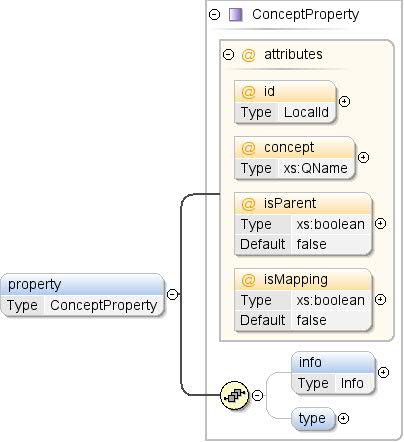 |
| タイプ |
ConceptProperty |
| プロパティ |
| content: |
複雑 |
| minOccurs: |
0 |
| maxOccurs: |
制限なし |
|
| モデル |
info{0,1}、type{0,1} |
| 子供 |
info、type |
| インスタンス |
<property concept="" id="" isMapping="false" isParent="false">
<info>{0,1}</info>
<type ref="">{0,1}</type>
</property>
|
| 属性 |
| QName |
タイプ |
固定 |
デフォルト |
使用 |
Annotation |
| コンセプト |
xs:QName |
|
|
省略可 |
値に対応するコンセプトへの参照
指定します。プロパティで型が指定されている場合、その型は
参照されるコンセプトのタイプと一致している必要があります。参照:
外部コンセプトは、
"prefix:other_concept_id"("prefix")
外部データセットの名前空間に使用される接頭辞(XML を参照
実装します。 |
| id |
LocalId |
|
|
省略可 |
コンセプト プロパティの ID。この識別子は、
(属性とプロパティ全体で)一意でなければなりません。「
コンセプト プロパティが指定されている場合、id は省略できます。その
ID は、サービス アカウントのローカル名の値で暗黙的に作成されます。
参照されるコンセプトです。例: <property
concept="geo:country"/><property> と同等です。
id="country"
concept="geo:country"/> |
| isMapping |
xs:boolean |
|
false |
省略可 |
true の場合、このプロパティはコンセプトを参照する必要があり、
このプロパティは、この 2 つのテーブル間のマッピング(1 対 1)
参照されるコンセプトです参照される各インスタンスは、
各コンセプトは、最大 1 つのインスタンスで
コンセプトです。 |
| isParent |
xs:boolean |
|
false |
省略可 |
true の場合、このプロパティはコンセプトを参照する必要があり、
このプロパティは、この 2 つのエンティティ間の
参照されるコンセプト(例: 大陸の大陸)を
国)。 |
|
| ソース |
<xs:element name="property" type="ConceptProperty" minOccurs="0" maxOccurs="unbounded">
<xs:annotation>
<xs:documentation>A property of the concept. Properties represent additional
information about instances of the concept (e.g., a concept
"city" may have a property "country").</xs:documentation>
</xs:annotation>
</xs:element>
|
要素: Concept / defaultValue
| 名前空間 |
http://schemas.google.com/dspl/2010 |
| アノテーション |
アプリケーションで使用するコンセプトのデフォルト値
選択可能な値のいずれかを選択する必要がある場合に、
コンセプトです。 |
| 図 |
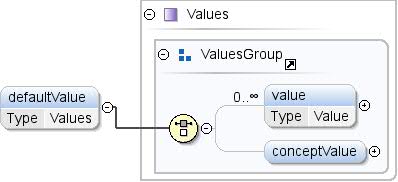 |
| タイプ |
値 |
| プロパティ |
|
| モデル |
値* |conceptValue{0,1} |
| 子供 |
conceptValue、value |
| インスタンス |
<defaultValue>
<value lang="">{0,unbounded}</value>
<conceptValue concept="">{0,1}</conceptValue>
</defaultValue>
|
| ソース |
<xs:element name="defaultValue" type="Values" minOccurs="0">
<xs:annotation>
<xs:documentation>A default value for the concept, to be used by
applications when they need to pick one of the possible
values of the concept.</xs:documentation>
</xs:annotation>
</xs:element>
|
| 名前空間 |
http://schemas.google.com/dspl/2010 |
| アノテーション |
取り得るすべての値を含むテーブルへの参照
非定数の特性について見てみましょう。 |
| 図 |
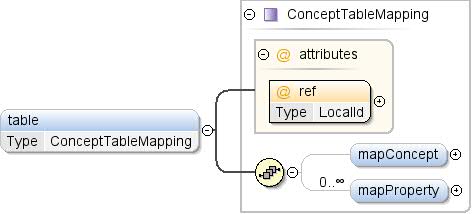 |
| タイプ |
ConceptTableMapping |
| プロパティ |
|
| モデル |
mapConcept{0,1} , mapProperty* |
| 子供 |
mapConcept、mapProperty |
| インスタンス |
<table ref="">
<mapConcept toColumn="">{0,1}</mapConcept>
<mapProperty lang="" ref="" toColumn="">{0,unbounded}</mapProperty>
</table>
|
| 属性 |
| QName |
タイプ |
固定 |
デフォルト |
使用 |
Annotation |
| 参照 |
LocalId |
|
|
必須 |
対象のデータを含むテーブルの ID
コンセプトです。 |
|
| ソース |
<xs:element name="table" type="ConceptTableMapping" minOccurs="0">
<xs:annotation>
<xs:documentation>A reference to a table that contains all the
possible values for the concept and its non-constant
properties.</xs:documentation>
</xs:annotation>
</xs:element>
|
複合型: コンセプト
| 名前空間 |
http://schemas.google.com/dspl/2010 |
| アノテーション |
コンセプトとは、
データセット(例:「GDP」「郡」など)を入力します。あるコンセプトは
すべての有効な値の列挙値と関連付けられています。
あるデータセットで定義したコンセプトが、別のデータセットで
。 |
| 図 |
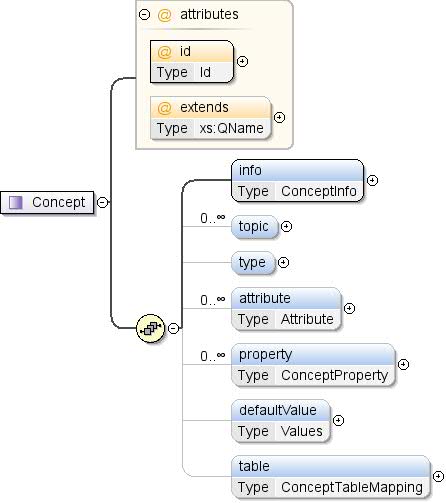 |
| 使用者 |
|
| モデル |
info、topic*、type{0,1}、
attribute*、property*、defaultValue{0,1}、table{0,1} |
| 子供 |
attribute、defaultValue、info、
property、table、topic、
タイプ |
| 属性 |
| QName |
タイプ |
固定 |
デフォルト |
使用 |
Annotation |
| 延長 |
xs:QName |
|
|
省略可 |
このコンセプトが持つコンセプトの一意の識別子
あります。参照されるコンセプトは、同じデータセットで定義できます。
外部、つまり別のデータセットです。外部 ID への参照は、
コンセプトは「prefix:other_concept_id」の形式にする必要があります。
「接頭辞」はは、名前の名前空間に使用される接頭辞です。
外部データセット(XML 名前空間を参照) |
| id |
ID |
|
|
必須 |
コンセプトを一意に識別する ID。
データセット内でグローバルに一意です |
|
| ソース |
<xs:complexType name="Concept">
<xs:annotation>
<xs:documentation>A concept is a definition of a type of data that appears in the
dataset (e.g., "GDP" or "County"). A concept may be associated with
an enumeration of all its possible values or not. A concept defined in
some dataset may be referenced in other datasets.</xs:documentation>
</xs:annotation>
<xs:sequence>
<xs:element name="info" type="ConceptInfo">
<xs:annotation>
<xs:documentation>Textual information, such as the name and description of
the concept.</xs:documentation>
</xs:annotation>
</xs:element>
<xs:element name="topic" minOccurs="0" maxOccurs="unbounded">
<xs:annotation>
<xs:documentation>A topic the concept is associated with.</xs:documentation>
</xs:annotation>
<xs:complexType>
<xs:attribute name="ref" type="xs:QName">
<xs:annotation>
<xs:documentation>The unique identifier of the topic this concept is
associated with.
The referenced topic may be defined in the same
dataset or externally, i.e., in another dataset. A
reference to an external topic must be of the form
"prefix:other_topic_id", where "prefix" is the prefix
used for the namespace of the external dataset (see
XML namespaces).</xs:documentation>
</xs:annotation>
</xs:attribute>
</xs:complexType>
</xs:element>
<xs:element name="type" minOccurs="0">
<xs:annotation>
<xs:documentation>The data type of the concept. A concept must provide a type declaration or extend
another concept. In the case where it's extending a concept, it may also
provide a type declaration. The type of the extended concept must be less restrictive
than the type of the concept extending it.
"Less restrictive than" (LRT) is a partial order defined as follows:
string LRT float
float LRT integer
string LRT date
string LRT boolean</xs:documentation>
</xs:annotation>
<xs:complexType>
<xs:attribute name="ref" type="DataType" use="required"/>
</xs:complexType>
</xs:element>
<xs:element name="attribute" type="Attribute" minOccurs="0" maxOccurs="unbounded">
<xs:annotation>
<xs:documentation>An attribute of the concept. Attributes represent additional
information about the concept (e.g., GDP is a percentage).</xs:documentation>
</xs:annotation>
</xs:element>
<xs:element name="property" type="ConceptProperty" minOccurs="0" maxOccurs="unbounded">
<xs:annotation>
<xs:documentation>A property of the concept. Properties represent additional
information about instances of the concept (e.g., a concept
"city" may have a property "country").</xs:documentation>
</xs:annotation>
</xs:element>
<xs:element name="defaultValue" type="Values" minOccurs="0">
<xs:annotation>
<xs:documentation>A default value for the concept, to be used by
applications when they need to pick one of the possible
values of the concept.</xs:documentation>
</xs:annotation>
</xs:element>
<xs:element name="table" type="ConceptTableMapping" minOccurs="0">
<xs:annotation>
<xs:documentation>A reference to a table that contains all the
possible values for the concept and its non-constant
properties.</xs:documentation>
</xs:annotation>
</xs:element>
</xs:sequence>
<xs:attribute name="id" type="Id" use="required">
<xs:annotation>
<xs:documentation>The unique identifier of the concept, which must be globally
unique within the dataset.</xs:documentation>
</xs:annotation>
</xs:attribute>
<xs:attribute name="extends" type="xs:QName" use="optional">
<xs:annotation>
<xs:documentation>The unique identifier of a concept that this
concept extends.
The referenced concept may be defined in the same
dataset or externally, i.e., in another dataset. A
reference to an external concept must be of the form
"prefix:other_concept_id", where "prefix" is the
prefix used for the namespace of the external
dataset (see XML namespaces).</xs:documentation>
</xs:annotation>
</xs:attribute>
</xs:complexType>
|
| 名前空間 |
名前空間がありません |
| アノテーション |
このコンセプトが関連付けられているトピックの一意の識別子
できます。参照先のトピックは、同じデータセットまたは
外部、つまり別のデータセットです。外部トピックへの参照
「prefix:other_topic_id」の形式にする必要があります。
"接頭辞"外部 IP アドレスの名前空間に使用される接頭辞です。
(XML 名前空間を参照)。 |
| タイプ |
xs:QName |
| プロパティ |
|
| 使用者 |
|
| ソース |
<xs:attribute name="ref" type="xs:QName">
<xs:annotation>
<xs:documentation>The unique identifier of the topic this concept is
associated with.
The referenced topic may be defined in the same
dataset or externally, i.e., in another dataset. A
reference to an external topic must be of the form
"prefix:other_topic_id", where "prefix" is the prefix
used for the namespace of the external dataset (see
XML namespaces).</xs:documentation>
</xs:annotation>
</xs:attribute>
|
| 名前空間 |
名前空間がありません |
| タイプ |
DataType |
| プロパティ |
|
| ファセット |
| enumeration |
文字列 |
|
| enumeration |
float |
|
| enumeration |
integer |
|
| enumeration |
ブール値 |
|
| enumeration |
date |
|
| enumeration |
concept |
|
|
| 使用者 |
|
| ソース |
<xs:attribute name="ref" type="DataType" use="required"/>
|
| 名前空間 |
名前空間がありません |
| アノテーション |
コンセプトを一意に識別する ID。グローバルに指定する必要があります。
一意である必要があります。 |
| タイプ |
ID |
| プロパティ |
|
| ファセット |
|
| 使用者 |
|
| ソース |
<xs:attribute name="id" type="Id" use="required">
<xs:annotation>
<xs:documentation>The unique identifier of the concept, which must be globally
unique within the dataset.</xs:documentation>
</xs:annotation>
</xs:attribute>
|
属性: コンセプト / @extends
| 名前空間 |
名前空間がありません |
| アノテーション |
このコンセプトが拡張するコンセプトの一意の識別子。
参照されるコンセプトは、同じデータセットまたは外部で定義できます。
つまり 別のデータセットに格納されます外部のコンセプトを参照する場合は、
「prefix:other_concept_id」の形式(「prefix」は
外部データセットの名前空間に使用される接頭辞(XML を参照
実装します。 |
| タイプ |
xs:QName |
| プロパティ |
|
| 使用者 |
|
| ソース |
<xs:attribute name="extends" type="xs:QName" use="optional">
<xs:annotation>
<xs:documentation>The unique identifier of a concept that this
concept extends.
The referenced concept may be defined in the same
dataset or externally, i.e., in another dataset. A
reference to an external concept must be of the form
"prefix:other_concept_id", where "prefix" is the
prefix used for the namespace of the external
dataset (see XML namespaces).</xs:documentation>
</xs:annotation>
</xs:attribute>
|
次を使用して作成:
oXygen XML エディタ。
特に記載のない限り、このページのコンテンツはクリエイティブ・コモンズの表示 4.0 ライセンスにより使用許諾されます。コードサンプルは Apache 2.0 ライセンスにより使用許諾されます。詳しくは、Google Developers サイトのポリシーをご覧ください。Java は Oracle および関連会社の登録商標です。
最終更新日 2025-07-25 UTC。
[[["わかりやすい","easyToUnderstand","thumb-up"],["問題の解決に役立った","solvedMyProblem","thumb-up"],["その他","otherUp","thumb-up"]],[["必要な情報がない","missingTheInformationINeed","thumb-down"],["複雑すぎる / 手順が多すぎる","tooComplicatedTooManySteps","thumb-down"],["最新ではない","outOfDate","thumb-down"],["翻訳に関する問題","translationIssue","thumb-down"],["サンプル / コードに問題がある","samplesCodeIssue","thumb-down"],["その他","otherDown","thumb-down"]],["最終更新日 2025-07-25 UTC。"],[],["Concepts, within a dataset (namespace: `http://schemas.google.com/dspl/2010`), define data types and are globally unique. Concepts can extend others, using `prefix:other_concept_id` for external references. They include `info` (textual details), `topic` (associated topics via `ref`), `type` (data type, `ref`), `attribute` (additional information), `property` (instance information), `defaultValue`, and `table` (data source, `ref`). Key concept attributes are `id` (unique), and `extends` (referencing another concept). External references are in `prefix:identifier` format. A concept must have a `type` or `extends`.\n"]]
